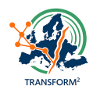Istituto Nazionale di Oceanografia e di Geofisica Sperimentale (OGS)
Role in TRANSFORM2
ISTITUTO NAZIONALE DI OCEANOGRAFIA E DI GEOFISICA SPERIMENTALE (OGS)
Address:
Borgo Grotta Gigante 42/C 34010 - Sgonico ( TS ) - Italy
The activities of OGS are designed to enhance and unify the monitoring tools and data processes within the framework of NITRO NFO. These enhancements are of paramount importance to the Regional Civil Defense, as they enable the swift dissemination of crucial information to the public and facilitate the efficient mobilization of initial assistance in the wake of significant seismic events. The comprehensive network of instrumentation, in conjunction with integrated measurements, provides an unparalleled level of spatio-temporal precision in seismic detection and localization, which is indispensable for monitoring the evolution of seismic sequences. In addition, we believe that the three activities outlined below in NITRO will significantly contribute to the TRASFORM2 project.
By exchanging technology and methodologies utilized in NFOs, we aim to add substantial value to the planned work packages (WPs) as described below:
1. GNSS Cost-effective prototype evaluation for crustal deformation purposes
Since 2002, OGS has developed and managed the permanent multi-constellation and multi-frequency GNSS site network Friuli Regional Deformation Network (FreDNet), which forms part of the monitoring system of northeastern Italy. Part of the FReDNet stations is included in the NFO NITRO. OGS, since 2015, has been committed to the development of cost-effective GNSS instrumentation called LZER0. It is proposed to conduct an extensive test in which the cost-effective stations created so far are installed in parallel with those of the OGS FReDNet network. To implement a complete station, the LZER0 devices will be connected to a cost-effective Calibrated Survey GNSS Tripleband + L-band antenna. The data collected by the stations of the FReDNet network and by the latest generation cost-effective stations will then be processed to produce displacement time series.
2. Automating Seismic Network Workflow Data Analysis using Machine Learning
The seismic network in NITRO-NFO generates vast amounts of data that require efficient and accurate analysis. This proposal aims to automate the workflow data analysis for NITRO using machine learning (ML). The primary objective is to develop an automated system that can process and analyze seismic network data accurately and efficiently. We propose to use ML for the detection and localization of seismic events.
3. DAS integration with seismic and geodetic instrumentation
The fiber optic segment of INSIEL's public telecommunications infrastructure will be integrated into the NFO-NITRO. This will make it possible to increase the detection threshold of low-magnitude events and thus improve the completeness of the local seismic catalogue. This will be useful in two ways: firstly, the new data will allow better control of temporal and spatial variations in small-scale seismicity, which can be interpreted from a prediction and forecasting perspective. In addition, the combined use of specific displacement techniques (e.g., template matching and double differences) will improve the knowledge of buried active structures and their depth extent.

